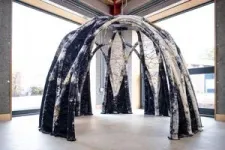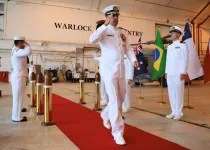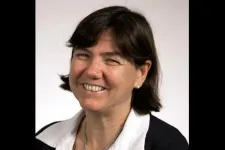(Press-News.org) Scientists hoping to reduce the environmental impact of the construction industry have developed a way to grow building materials using knitted molds and the root network of fungi. Although researchers have experimented with similar composites before, the shape and growth constraints of the organic material have made it hard to develop diverse applications that fulfil its potential. Using the knitted molds as a flexible framework or ‘formwork’, the scientists created a composite called ‘mycocrete’ which is stronger and more versatile in terms of shape and form, allowing the scientists to grow lightweight and relatively eco-friendly construction materials.
“Our ambition is to transform the look, feel and wellbeing of architectural spaces using mycelium in combination with biobased materials such as wool, sawdust and cellulose,” said Dr Jane Scott of Newcastle University, corresponding author of the paper in Frontiers in Bioengineering and Biotechnology. The research was carried out by a team of designers, engineers, and scientists in the Living Textiles Research Group, part of the Hub for Biotechnology in the Built Environment at Newcastle University, which is funded by Research England.
Root networks
To make composites using mycelium, part of the root network of fungi, scientists mix mycelium spores with grains they can feed on and material that they can grow on. This mixture is packed into a mold and placed in a dark, humid, and warm environment so that the mycelium can grow, binding the substrate tightly together. Once it’s reached the right density, but before it starts to produce the fruiting bodies we call mushrooms, it is dried out. This process could provide a cheap, sustainable replacement for foam, timber, and plastic. But mycelium needs oxygen to grow, which constrains the size and shape of conventional rigid molds and limits current applications.
Knitted textiles offer a possible solution: oxygen-permeable molds that could change from flexible to stiff with the growth of the mycelium. But textiles can be too yielding, and it is difficult to pack the molds consistently. Scott and her colleagues set out to design a mycelium mixture and a production system that could exploit the potential of knitted forms.
“Knitting is an incredibly versatile 3D manufacturing system,” said Scott. “It is lightweight, flexible, and formable. The major advantage of knitting technology compared to other textile processes is the ability to knit 3D structures and forms with no seams and no waste.”
Samples of conventional mycelium composite were prepared by the scientists as controls, and grown alongside samples of mycocrete, which also contained paper powder, paper fiber clumps, water, glycerin, and xanthan gum. This paste was designed to be delivered into the knitted formwork with an injection gun to improve packing consistency: the paste needed to be liquid enough for the delivery system, but not so liquid that it failed to hold its shape.
Tubes for their planned test structure were knitted from merino yarn, sterilized, and fixed to a rigid structure while they were filled with the paste, so that changes in tension of the fabric would not affect the performance of the mycocrete.
Building the future
Once dried, samples were subjected to strength tests in tension, compression and flexion. The mycocrete samples proved to be stronger than the conventional mycelium composite samples and outperformed mycelium composites grown without knitted formwork. In addition, the porous knitted fabric of the formwork provided better oxygen availability, and the samples grown in it shrank less than most mycelium composite materials do when they are dried, suggesting more predictable and consistent manufacturing results could be achieved.
The team were also able to build a larger proof-of-concept prototype structure called BioKnit - a complex freestanding dome constructed in a single piece without joins that could prove to be weak points, thanks to the flexible knitted form.
“The mechanical performance of the mycocrete used in combination with permanent knitted formwork is a significant result, and a step towards the use of mycelium and textile biohybrids within construction,” said Scott. “In this paper we have specified particular yarns, substrates, and mycelium necessary to achieve a specific goal. However, there is extensive opportunity to adapt this formulation for different applications. Biofabricated architecture may require new machine technology to move textiles into the construction sector.”
END
Scientists knit futuristic eco-building designs using fungal networks
Mycocrete, a paste made with fungi, can be combined with a knitted textile framework to create environmentally friendly constructions
2023-07-14
ELSE PRESS RELEASES FROM THIS DATE:
Ketamine effective for treatment-resistant depression: clinical trial
2023-07-14
A low-cost version of ketamine to treat severe depression has performed strongly in a double-blind trial that compared it with placebo.
In research published today in the British Journal of Psychiatry, researchers led by UNSW Sydney and the affiliated Black Dog Institute found that more than one in five participants achieved total remission from their symptoms after a month of bi-weekly injections, while a third had their symptoms improve by at least 50 per cent. The study was a collaboration between ...
Welcome, Big Tuna! New commanding officer takes command at the Office of Naval Research Global
2023-07-14
The Office of Naval Research (ONR) Global, ONR’s international arm, welcomed new leadership today, as Capt. Andy “Big Tuna” Berner was sworn in as the new ONR Global commanding officer during a ceremony at Naval Air Station Patuxent River, Maryland. Berner takes over for Capt. Matthew Farr.
Chief of Naval Research Rear Adm. Kurt Rothenhaus served as presiding officer of the change-of-command ceremony, as well as presenter of awards.
“Learning from our partners and allies ...
Delayed RSV prophylactic during atypical RSV surges and RSV hospitalization spikes in high-risk kids
2023-07-14
As a result of the COVID-19 pandemic, respiratory syncytial virus (RSV) surges in young children occurred outside the usual November to March season, when immune-based prophylactic is available to protect children at high risk for severe illness. In 2021, RSV season began in May, leaving these kids without a prophylactic until September, due to lack of drug availability and challenges with insurance authorization for off-season administration. During this time, pediatric hospitalizations for RSV in 2021-2022 spiked and ...
THE LANCET HEALTHY LONGEVITY: Razor-sharp memory function in older adults linked to faster movement and better mental health, study suggests
2023-07-14
Peer-reviewed / Observational study / People
One of the largest observational studies to date of ‘superagers’ – people in their eighties with the memory function of people decades younger – suggests they also move more quickly and have better mental health than typical older adults.
MRI scans add to evidence that superagers have more grey matter in key regions linked to memory function.
No differences in biomarkers or genetic risk factors for neurodegenerative disease were detected between superagers and typical older adults, suggesting ...
App helps identify autistic children in India – study
2023-07-14
Children with autism and related neurodevelopmental disorders in India can be successfully identified by community healthcare workers using a low-cost app, a study has found.
The results, published today (Friday 14 July) in Autism, could open the door to help millions of children with autism spectrum conditions to get earlier screening quickly and inexpensively, leading to life-changing support.
Researchers from India, the UK and US tested the app with 131 two- to seven-year-olds living in low-resource neighbourhoods of Delhi, India.
The tests were carried out at the homes of the children, by non-specialist ...
Geological Society of America announces 2023–2024 Officers and Councilors
2023-07-14
13 July 2023
The Geological Society of America
Release no. 23-26
Contact: Justin Samuel
+1-303-357-1026
jsamuel@geosociety.org
For Immediate Release
Geological Society of America Announces 2023–2024 Officers and Councilors
Boulder, Colo., USA: Christopher (Chuck) M. Bailey, College of William & Mary, Williamsburg, Virginia, takes over the role of president of The Geological Society of America as of 1 July 2023. The incoming president-elect is Carmala N. Garzione, University of Arizona, Tucson, Arizona.
Rounding ...
Multimillion dollar consortium to address southwest water concerns
2023-07-14
The Colorado River, which provides drinking water to tens of millions of people and irrigation water to more than 5 million acres of farmland, has dropped by one-third in recent years. Arizona recently limited housing construction in the Phoenix area based on projections that groundwater will be unable to meet growing demand.
The University of Arizona has received $4 million for phase one of a project to improve water security and water reuse methods in the arid southwestern United States. Phase two will be awarded an ...
Media Tip Sheet: Ecology of the Pacific Northwest and the Cascadia Bioregion
2023-07-14
Dozens of sessions at the Ecological Society of America’s upcoming Annual Meeting in Portland, Oregon, Aug. 6-11, will feature research on the ecology of the geographic and environmental region surrounding the conference venue: the Pacific Northwest and Cascadia Bioregion, which encompass a vast area stretching from northern California to southern Alaska.
The Pacific Northwest’s temperate rainforests are home to old-growth conifers and multiple threatened and endangered species. Its diverse marine and coastal environments host whales, puffins and vibrant kelp forests. The annual salmon runs in the region’s ...
Researchers’ sweeping discovery shows how kidney cells self-renew
2023-07-13
University of Texas at Dallas scientists have discovered a previously unknown “housekeeping” process in kidney cells that ejects unwanted content, resulting in cells that rejuvenate themselves and remain functioning and healthy.
The self-renewal process, which is fundamentally different from how other bodily tissues are thought to regenerate, helps explain how, barring injury or disease, the kidneys can remain healthy for a lifetime. The researchers described the mechanism in a study published April 17 in Nature Nanotechnology.
Unlike ...
Rensselaer researcher receives grant to study enzymes in deep sea organisms
2023-07-13
Rensselaer Polytechnic Institute’s Catherine Royer, Constellation Chair Professor of Bioinformatics and Biocomputation at the Shirley Ann Jackson, Ph.D. Center for Biotechnology and Interdisciplinary Studies (CBIS) and professor of biological sciences, has received a grant of over $400,000 from the National Science Foundation to investigate enzymes from organisms living in deep sea environments.
“Ultimately, I hope to better understand how these enzymes function under the high pressure that is present in the deep sea,” said Royer. “They also thrive in high or low temperatures. Biomolecules from the surface do not have the ability to survive these extreme ...
LAST 30 PRESS RELEASES:
Current Molecular Pharmacology achieves a landmark: real-time CiteScore advances to 7.2
Skeletal muscle epigenetic clocks developed using postmortem tissue from an Asian population
Estimating unemployment rates with social media data
Climate policies can backfire by eroding “green” values, study finds
Too much screen time too soon? A*STAR study links infant screen exposure to brain changes and teen anxiety
Global psychiatry mourns Professor Dan Stein, visionary who transformed mental health science across Africa and beyond
KIST develops eco-friendly palladium recovery technology to safeguard resource security
Statins significantly reduce mortality risk for adults with diabetes, regardless of cardiovascular risk
Brain immune cells may drive more damage in females than males with Alzheimer’s
Evidence-based recommendations empower clinicians to manage epilepsy in pregnancy
Fungus turns bark beetles’ defenses against them
There are new antivirals being tested for herpesviruses. Scientists now know how they work
CDI scientist, colleagues author review of global burden of fungus Candida auris
How does stroke influence speech comprehension?
B cells transiently unlock their plasticity, risking lymphoma development
Advanced AI dodel predicts spoken language outcomes in deaf children after cochlear implants
Multimodal imaging-based cerebral blood flow prediction model development in simulated microgravity
Accelerated streaming subgraph matching framework is faster, more robust, and scalable
Gestational diabetes rose every year in the US since 2016
OHSU researchers find breast cancer drug boosts leukemia treatment
Fear and medical misinformation regarding risk of progression or recurrence among patients with breast cancer
Glucagonlike peptide-1 receptor agonists and asthma risk in adolescents with obesity
Reviving dormant immunity: Millimeter waves reprogram the immunosuppressive microenvironment to potentiate immunotherapy without obvious side effects
Safety decision-making for autonomous vehicles integrating passenger physiological states by fNIRS
Fires could emit more air pollution than previously estimated
A new way to map how cells choose their fate
Numbers in our sights affect how we perceive space
SIMJ announces global collaborative book project in commemoration of its 75th anniversary
Air pollution exposure and birth weight
Obstructive sleep apnea risk and mental health conditions among older adults
[Press-News.org] Scientists knit futuristic eco-building designs using fungal networksMycocrete, a paste made with fungi, can be combined with a knitted textile framework to create environmentally friendly constructions






